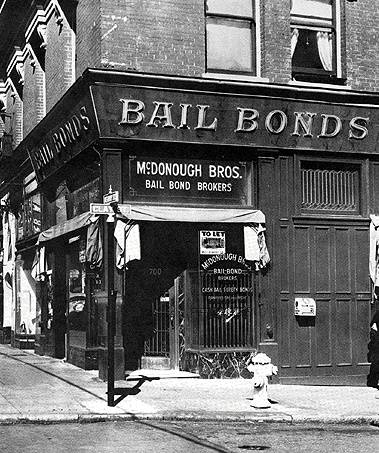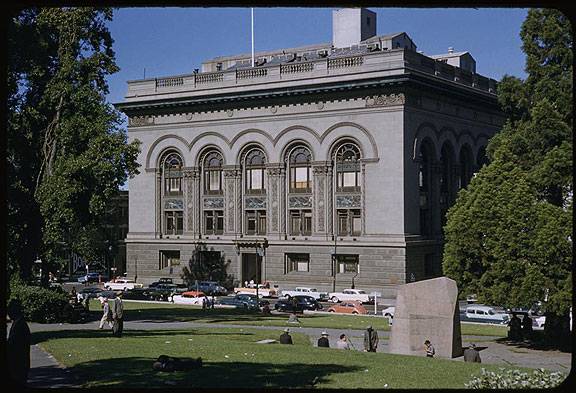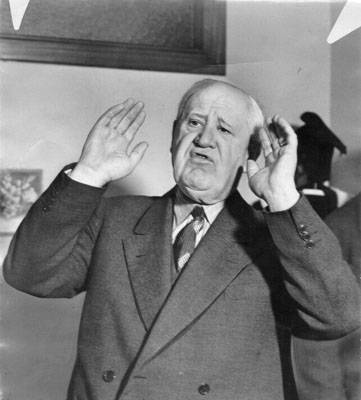CORRUPTION CENTRAL: PETER P. McDONOUGH: Difference between revisions
m (1 revision(s)) |
(added Cushman photo with link) |
||
| (8 intermediate revisions by the same user not shown) | |||
| Line 1: | Line 1: | ||
'''<font face = Papyrus> <font color = maroon> <font size = 4>Historical Essay</font></font> </font>''' | |||
''by Merritt Barnes '' | |||
[[Image:downtwn1$mcdonough-bail-bonds.jpg]] | [[Image:downtwn1$mcdonough-bail-bonds.jpg]] | ||
'''McDonough Brothers Bail Bond office, early 20th century''' | '''McDonough Brothers Bail Bond office, early 20th century''' | ||
Picking up in the wake of the discredited [[Abe Ruef and the Union Labor Party Boss Ruef Machine]], Peter McDonough and his brother Tom, owners of a saloon at Kearny and Clay, became the central leaders of San Francisco crime life in the period 1910-1941. Al Capone was quoted as saying, | ''Photo: San Francisco History Center, San Francisco Public Library'' | ||
Picking up in the wake of the discredited [[Abe Ruef and the Union Labor Party |Boss Ruef Machine]], Peter McDonough and his brother Tom, owners of a saloon at Kearny and Clay, became the central leaders of San Francisco crime life in the period 1910-1941. Al Capone was quoted as saying, "the more lucrative forms of crime were so highly organized and well protected that outsiders couldn't break into San Francisco." McDonough's quiet, unobtrusive, efficient and locally-owned management of the vice trade included ample protection from all levels of the police department, which perhaps explains why the city was spared the violent gangland confrontations that plagued eastern cities. | |||
San Francisco was always an open town for prostitution and gambling. When the [[Abe Ruef and the Union Labor Party |Union Labor Party]] scandals broke after the earthquake, popular support for reform was soon satisfied, and by 1910 a majority of San Franciscans wanted a return to the prosperous business conditions that existed pre-earthquake. Common was the admonition, "don't talk earthquake, talk business." The big corporate leaders who had been the source of bribes and corruption, lawyers and executives from Southern Pacific, United Railroads, PG&E, Pacific Telephone, and so on, remained untouched as they were acquitted or their indictments were withdrawn. Convicted Mayor Schmitz''' '''had his case thrown out on a technicality and never served any time. | |||
Into this void stepped the McDonough brothers, Pete gaining the moniker "King of the Tenderloin." After being born and raised in the Cow Hollow (now Marina) district, Pete and his brother Tom took over their father's bar, a landmark which had survived the May 3, 1851 fire and the 1906 earthquake and fire. With its close proximity to the then Hall of Justice on Montgomery, Pete had by 1896 developed the first ever bail bond business at "The Corner," as it was known. As time went on, Peter McDonough and his representatives built a powerful business by providing all possible services for an accused person, from posting bond to providing a lawyer. A pioneer in the "information services" industry that dominates late 20th century SF, McDonough developed a network of wireless communications with outlying police stations. Within minutes of an arrest, McDonough's nephew was hailing a taxi to find a judge to sign an OR (order of release) form, and the client was soon free. Naturally, everyone was on the take, and McDonough was raking it in. | |||
[[Image:Cushman-May-25-1958-Portsmouth-Sq-and-Hall-ofJustice-P09936.jpg]] | |||
'''The Old Hall of Justice on Montgomery Street across from Portsmouth Square, May 25, 1958.''' | |||
[http://webapp1.dlib.indiana.edu/cushman/ ''Charles Cushman Collection: Indiana University Archives (P09936)''] | |||
He soon expanded into protection and it was commonly acknowledged in the press that McDonough's organization was bribing everyone in sight. A grand jury concluded | He soon expanded into protection and it was commonly acknowledged in the press that McDonough's organization was bribing everyone in sight. A grand jury concluded "No one can conduct a prostitution or gambling enterprise in San Francisco with the approval direct or indirect of the McDonough brothers." When Pete McDonough was convicted during the Prohibition on bootlegging, a final unsuccessful appeal for clemency from the governor was signed by a former California governor, the secretary of state, [[Mayor "Sunny Jim" Rolph|Mayor James Rolph]], three congressmen, one police commissioner, one judge of the appellate court, eleven superior court judges, two justices of the peace, four police judges, the city clerk, auditor, recorder, coroner, treasurer, tax collector, district attorney, three assistant district attorneys, and the vice president of the Bank of Italy (later Bank of America). | ||
The day-to-day corruption followed the pattern illustrated in a 1910 ''San Francisco Bulletin ''article. A meeting between Mayor P.H. McCarthy's executive secretary, Elmore Leffingwell, and a | The day-to-day corruption followed the pattern illustrated in a 1910 ''San Francisco Bulletin ''article. A meeting between Mayor P.H. McCarthy's executive secretary, Elmore Leffingwell, and a "McDonough lieutenant," professional gambler Frank Daroux, was arranged at a French restaurant called the Chantilly. By the conclusion of the meeting, Daroux was given permission to open two gambling clubs without police interference in exchange for a percentage of the revenue to wipe out a $12,000 deficit incurred in McCarthy's 1909 campaign. | ||
Pete McDonough was also a friend to the working man and his organizations. He often provided free bail to men arrested in strikes, and had been given a commemorative plaque for his support to arrested strikers in the 1907-08 streetcar strike. The Building and Metal Trades rose to his defense when he was accused of bribery. During the attempt to get a pardon on his 1923 bootlegging conviction, the San Francisco Labor Council issued a statement calling McDonough | Pete McDonough was also a friend to the working man and his organizations. He often provided free bail to men arrested in strikes, and had been given a commemorative plaque for his support to arrested strikers in the [[Bloody Tuesday|1907-08 streetcar strike]]. The Building and Metal Trades rose to his defense when he was accused of bribery. During the attempt to get a pardon on his 1923 bootlegging conviction, the San Francisco Labor Council issued a statement calling McDonough "at all times a valuable and consistent friend of organized labor." | ||
[[Image:District attorney Matthew Brady 1937 AAA-5706.jpg]] | |||
'''March 26, 1937: Arms raised, District Attorney Matthew Brady today declared he was not indebted to McDonough Brothers and never had business transactions with them. When questioned concerning the $1100 note purportedly held by Peter J. ("Pete") McDonough, Brady declared the indebtness was "an out and out lie." He seeks to question McDonough concerning the note the latter holds.''' | |||
''Photo: San Francisco History Center, SF Public Library'' | |||
'' | McDonough's empire started to unravel under the disintegrating pressure of the Depression in the early 1930's. The traditional political leaders in government and organized labor with whom he was in close contact lost their power as rising social militancy led to the [[The General Strike of 1934|1934 General Strike]], the rise of the CIO and a Roosevelt-ian surge in the Democratic Party. By 1935 the FBI had sent agent Edwin Atherton to investigate police corruption. His report named 67 police and 24 government officials, asserting that "McDonough Brothers was found to be a fountainhead of corruption willing to interest itself in almost any matter designed to defeat or circumvent the law." When his support evaporated in the heat of the political climate, McDonough was ultimately stripped of his bail bond license and his power was soon broken. | ||
from ''FOUNTAINHEAD OF CORRUPTION: Peter P. McDonough, Boss of San Francisco's Underworld'' by Merritt Barnes (''California History'', Volume LVIII, Summer 1979 No. 2) p. 142 | |||
[[Ships under Financial District | Prev. Document]] [[San Francisco's Sleaziest Street - Yesterday and Today | Next Document]] | |||
[[ | [[category:Downtown]] [[category:1910s]] [[category:1920s]] [[category:1930s]] [[category:1940s]] [[category:crime]] [[category:Famous characters]] | ||
Latest revision as of 15:55, 1 July 2009
Historical Essay
by Merritt Barnes
McDonough Brothers Bail Bond office, early 20th century
Photo: San Francisco History Center, San Francisco Public Library
Picking up in the wake of the discredited Boss Ruef Machine, Peter McDonough and his brother Tom, owners of a saloon at Kearny and Clay, became the central leaders of San Francisco crime life in the period 1910-1941. Al Capone was quoted as saying, "the more lucrative forms of crime were so highly organized and well protected that outsiders couldn't break into San Francisco." McDonough's quiet, unobtrusive, efficient and locally-owned management of the vice trade included ample protection from all levels of the police department, which perhaps explains why the city was spared the violent gangland confrontations that plagued eastern cities.
San Francisco was always an open town for prostitution and gambling. When the Union Labor Party scandals broke after the earthquake, popular support for reform was soon satisfied, and by 1910 a majority of San Franciscans wanted a return to the prosperous business conditions that existed pre-earthquake. Common was the admonition, "don't talk earthquake, talk business." The big corporate leaders who had been the source of bribes and corruption, lawyers and executives from Southern Pacific, United Railroads, PG&E, Pacific Telephone, and so on, remained untouched as they were acquitted or their indictments were withdrawn. Convicted Mayor Schmitz had his case thrown out on a technicality and never served any time.
Into this void stepped the McDonough brothers, Pete gaining the moniker "King of the Tenderloin." After being born and raised in the Cow Hollow (now Marina) district, Pete and his brother Tom took over their father's bar, a landmark which had survived the May 3, 1851 fire and the 1906 earthquake and fire. With its close proximity to the then Hall of Justice on Montgomery, Pete had by 1896 developed the first ever bail bond business at "The Corner," as it was known. As time went on, Peter McDonough and his representatives built a powerful business by providing all possible services for an accused person, from posting bond to providing a lawyer. A pioneer in the "information services" industry that dominates late 20th century SF, McDonough developed a network of wireless communications with outlying police stations. Within minutes of an arrest, McDonough's nephew was hailing a taxi to find a judge to sign an OR (order of release) form, and the client was soon free. Naturally, everyone was on the take, and McDonough was raking it in.
The Old Hall of Justice on Montgomery Street across from Portsmouth Square, May 25, 1958.
Charles Cushman Collection: Indiana University Archives (P09936)
He soon expanded into protection and it was commonly acknowledged in the press that McDonough's organization was bribing everyone in sight. A grand jury concluded "No one can conduct a prostitution or gambling enterprise in San Francisco with the approval direct or indirect of the McDonough brothers." When Pete McDonough was convicted during the Prohibition on bootlegging, a final unsuccessful appeal for clemency from the governor was signed by a former California governor, the secretary of state, Mayor James Rolph, three congressmen, one police commissioner, one judge of the appellate court, eleven superior court judges, two justices of the peace, four police judges, the city clerk, auditor, recorder, coroner, treasurer, tax collector, district attorney, three assistant district attorneys, and the vice president of the Bank of Italy (later Bank of America).
The day-to-day corruption followed the pattern illustrated in a 1910 San Francisco Bulletin article. A meeting between Mayor P.H. McCarthy's executive secretary, Elmore Leffingwell, and a "McDonough lieutenant," professional gambler Frank Daroux, was arranged at a French restaurant called the Chantilly. By the conclusion of the meeting, Daroux was given permission to open two gambling clubs without police interference in exchange for a percentage of the revenue to wipe out a $12,000 deficit incurred in McCarthy's 1909 campaign.
Pete McDonough was also a friend to the working man and his organizations. He often provided free bail to men arrested in strikes, and had been given a commemorative plaque for his support to arrested strikers in the 1907-08 streetcar strike. The Building and Metal Trades rose to his defense when he was accused of bribery. During the attempt to get a pardon on his 1923 bootlegging conviction, the San Francisco Labor Council issued a statement calling McDonough "at all times a valuable and consistent friend of organized labor."
March 26, 1937: Arms raised, District Attorney Matthew Brady today declared he was not indebted to McDonough Brothers and never had business transactions with them. When questioned concerning the $1100 note purportedly held by Peter J. ("Pete") McDonough, Brady declared the indebtness was "an out and out lie." He seeks to question McDonough concerning the note the latter holds.
Photo: San Francisco History Center, SF Public Library
McDonough's empire started to unravel under the disintegrating pressure of the Depression in the early 1930's. The traditional political leaders in government and organized labor with whom he was in close contact lost their power as rising social militancy led to the 1934 General Strike, the rise of the CIO and a Roosevelt-ian surge in the Democratic Party. By 1935 the FBI had sent agent Edwin Atherton to investigate police corruption. His report named 67 police and 24 government officials, asserting that "McDonough Brothers was found to be a fountainhead of corruption willing to interest itself in almost any matter designed to defeat or circumvent the law." When his support evaporated in the heat of the political climate, McDonough was ultimately stripped of his bail bond license and his power was soon broken.
from FOUNTAINHEAD OF CORRUPTION: Peter P. McDonough, Boss of San Francisco's Underworld by Merritt Barnes (California History, Volume LVIII, Summer 1979 No. 2) p. 142



